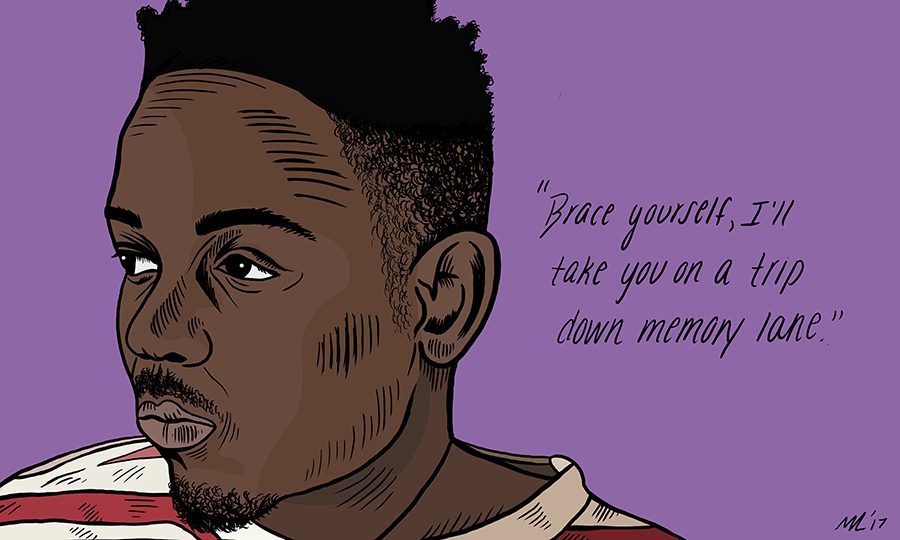Five years later, “good kid, m.A.A.d city” remains a singular achievement in hip-hop
Photo by Megan Little | For the Globe
Kendrick Lamar’s 2012 album “good kid, m.A.A.d city” continues to compel audiences in 2017.
October 31, 2017
In 2017, Kendrick Lamar released his double platinum album “DAMN.” This record was the culmination of years of bridging the gap between mainstream popularity and socially conscious lyricism.
Lamar took his first substantial step down this path in October 2012 with his major label debut, “good kid, m.A.A.d city” (“GKMC”).
“GKMC” acted as the catalyst for Lamar’s mainstream career, with its stories and themes continuing to permeate Lamar’s work. The story of police brutality in the track “good kid” foreshadows the large-scale social commentary of “To Pimp a Butterfly,” while the panicked energy of “m.A.A.d city” acts as a precursor to the anger of “XXX.” on “DAMN.”
Featuring production from industry heavyweights (Pharrell, Just Blaze, Hit Boy) and Lamar’s in-house team (Sounwave, DJ Dahi, Terrace Martin), the album’s sonics sound fresh to this day, while many other records of the time have already begun to sound dated (Nicki Minaj’s “Pink Friday: Roman Reloaded” for instance).
The album’s overarching story revolves around a transformative day in Lamar’s adolescence. Since Lamar made this theme the focus of “GKMC,” many artists have done similar retrospectives into their young lives.
J. Cole revisited his childhood home with “2014 Forest Hills Drive.” Vince Staples recounted his upbringing in Long Beach in “Summertime ’06.” Even Frank Ocean was seen dipping into the impressionable experiences of his youth on 2016’s “Blonde.”
Lamar was not the first person to tell stories about his upbringing, but his ability to do so with such clarity and poignancy had a clear effect on his contemporaries.
Released when Lamar was only 25, the album saw him miles ahead of many of his peers. While Jay Z and Kanye West were focused on the punchlines and braggadocio, boastful or arrogant behavior, of “Watch the Throne,” Lamar had his eyes on larger themes: gang violence, the disenfranchisement of the black community and generational alcoholism.
Though “Watch the Throne” had a few songs dealing with socially conscious ideas (“New Day,” “Made in America”), these tracks are weighed down by the excess and smugness that makes up most of the record (“Who Gon Stop Me,” “Gotta Have It”).
“GKMC” finds Lamar often taking the role of his teenage self, making him far more relatable than the superstar personas of West and Jay Z. Even in his moments of braggadocio (“Backseat Freestyle”), we know it is the façade of a young man trying to impress his friends.
This everyman persona is where “GKMC” shines brightest. Lamar’s greatest attribute has always been his storytelling, and “GKMC” is filled to the brim with incredible tales.
“The Art of Peer Pressure” finds our protagonist smoking and stealing, acting out of character in order to impress his friends. “Sherane a.k.a Master Splinter’s Daughter” tells the story of a young man blinded by lust.
Both of these songs recount experiences which aren’t entirely relatable to the average listener, but Lamar’s ability to put the audience into the mind of a teenager being pulled in so many directions is what makes the album resonate so deeply.
Much of the album recounts experiences that are specific to communities of color. In doing this, the music that makes up “GKMC” is deeply ingrained in the culture of Lamar’s home of Compton, as well as the black community at large. Songs sample Bill Withers, B.B. King and Janet Jackson. Lamar’s lyrics reference E-40, and Compton legends Dr. Dre and MC Eiht make memorable appearances.
“Sing About Me, I’m Dying of Thirst” is the album’s masterpiece. In the first two verses, Lamar addresses himself from the point of view of two characters: his friend, Dave, and the sister of Keisha, a woman who Lamar rapped about on 2011’s “Section .80.” In the third verse, Lamar shifts the view back to himself as he addresses Dave’s brother and Keisha’s sister.
The song is a sobering view of how such personal art can affect the lives of its subjects. Lamar’s ability to criticize himself as something of an unreliable narrator shifts our perspective of every story he has told us so far, and also serves to humanize the characters in his songs.
The latter point is also evident on “m.A.A.d city,” where the name of an accomplice of a shooting is censored. Lamar states to Genius.com that the story is so “serious and in-depth” that the mention of a name could put real people in jeopardy.
Though “Section .80” was what put Lamar on the map of many hip-hop fans, “GKMC” thrust him into the spotlight. It remains the most important album of his career.
Lamar’s “To Pimp a Butterfly” has been one of the most highly rated hip-hop albums of all time, sitting at number one on over 50 best of 2015 lists. Without the success of “GKMC,” “To Pimp a Butterfly” would have had little to no impact. Its dense themes, production and storytelling would have been overlooked by many had “GKMC” not solidified Lamar as an artist worth listening to.
Similarly, 2017’s “DAMN.” would have probably been a massive commercial failure.
“To Pimp a Butterfly,” while not a commercial failure, took nearly a year to go platinum. This was only after the Recording Industry Association of America (RIAA) changing their rules to include digital streaming in the certification process. Without “GKMC’s” legacy, much of the general public would have forgotten about Lamar by the time “DAMN.” released.
But “GKMC” is larger than its influence; its stories will continue to inspire musicians and fans for generations. It serves as a portrait of the artist as a young man, and is a snapshot into a world many Americans know nothing about.
More than anything, “GKMC” is the quintessential story of a young boy becoming a man.




















marcus • Feb 7, 2019 at 4:51 PM
man you’re are straight hating on to pimp a butterfly.